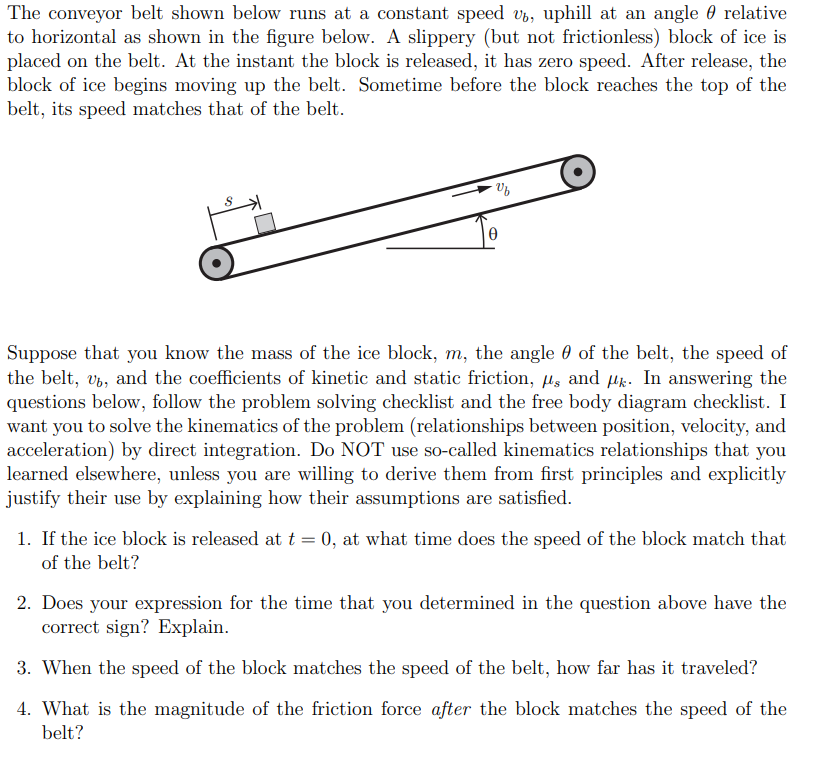The conveyor belt shown below runs at a constant speed vp, uphill at an angle 0 relative to horizontal as shown in the figure below. A slippery (but not frictionless) block of ice is placed on the belt. At the instant the block is released, it has zero speed. After release, the block of ice begins moving up the belt. Sometime before the block reaches the top of the belt, its speed matches that of the belt. Suppose that you know the mass of the ice block, m, the angle 0 of the belt, the speed of the belt, vp, and the coefficients of kinetic and static friction, µs and µk. In answering the questions below, follow the problem solving checklist and the free body diagram checklist. I want you to solve the kinematics of the problem (relationships between position, velocity, and acceleration) by direct integration. Do NOT use so-called kinematics relationships that you learned elsewhere, unless you are willing to derive them from first principles and explicitly justify their use by explaining how their assumptions are satisfied. 1. If the ice block is released at t = 0, at what time does the speed of the block match that of the belt? 2. Does your expression for the time that you determined in the question above have the correct sign? Explain. 3. When the speed of the block matches the speed of the belt, how far has it traveled? 4. What is the magnitude of the friction force after the block matches the speed of the belt?
The conveyor belt shown below runs at a constant speed vp, uphill at an angle 0 relative to horizontal as shown in the figure below. A slippery (but not frictionless) block of ice is placed on the belt. At the instant the block is released, it has zero speed. After release, the block of ice begins moving up the belt. Sometime before the block reaches the top of the belt, its speed matches that of the belt. Suppose that you know the mass of the ice block, m, the angle 0 of the belt, the speed of the belt, vp, and the coefficients of kinetic and static friction, µs and µk. In answering the questions below, follow the problem solving checklist and the free body diagram checklist. I want you to solve the kinematics of the problem (relationships between position, velocity, and acceleration) by direct integration. Do NOT use so-called kinematics relationships that you learned elsewhere, unless you are willing to derive them from first principles and explicitly justify their use by explaining how their assumptions are satisfied. 1. If the ice block is released at t = 0, at what time does the speed of the block match that of the belt? 2. Does your expression for the time that you determined in the question above have the correct sign? Explain. 3. When the speed of the block matches the speed of the belt, how far has it traveled? 4. What is the magnitude of the friction force after the block matches the speed of the belt?
International Edition---engineering Mechanics: Statics, 4th Edition
4th Edition
ISBN:9781305501607
Author:Andrew Pytel And Jaan Kiusalaas
Publisher:Andrew Pytel And Jaan Kiusalaas
Chapter7: Dry Friction
Section: Chapter Questions
Problem 7.78P: The figure shows a steel bar being processed by a rolling mill. Given that P=80kN and r =0.016,...
Related questions
Question
see image

Transcribed Image Text:The conveyor belt shown below runs at a constant speed vb, uphill at an angle 0 relative
to horizontal as shown in the figure below. A slippery (but not frictionless) block of ice is
placed on the belt. At the instant the block is released, it has zero speed. After release, the
block of ice begins moving up the belt. Sometime before the block reaches the top of the
belt, its speed matches that of the belt.
Suppose that you know the mass of the ice block, m, the angle 0 of the belt, the speed of
the belt, vh, and the coefficients of kinetic and static friction, µs and uk. In answering the
questions below, follow the problem solving checklist and the free body diagram checklist. I
want you to solve the kinematics of the problem (relationships between position, velocity, and
acceleration) by direct integration. Do NOT use so-called kinematics relationships that you
learned elsewhere, unless you are willing to derive them from first principles and explicitly
justify their use by explaining how their assumptions are satisfied.
1. If the ice block is released at t = 0, at what time does the speed of the block match that
of the belt?
2. Does your expression for the time that you determined in the question above have the
correct sign? Explain.
3. When the speed of the block matches the speed of the belt, how far has it traveled?
4. What is the magnitude of the friction force after the block matches the speed of the
belt?
Expert Solution
Step 1
Since you have posted a question with multiple sub-parts, we will solve the first three subparts for you. To get the remaining sub-part solved please repost the complete question and mention the sub-parts to be solved
Given :

To find:
Time to reach max speed, distance travelled before reaching max speed
Trending now
This is a popular solution!
Step by step
Solved in 3 steps with 1 images

Knowledge Booster
Learn more about
Need a deep-dive on the concept behind this application? Look no further. Learn more about this topic, mechanical-engineering and related others by exploring similar questions and additional content below.Recommended textbooks for you

International Edition---engineering Mechanics: St…
Mechanical Engineering
ISBN:
9781305501607
Author:
Andrew Pytel And Jaan Kiusalaas
Publisher:
CENGAGE L

International Edition---engineering Mechanics: St…
Mechanical Engineering
ISBN:
9781305501607
Author:
Andrew Pytel And Jaan Kiusalaas
Publisher:
CENGAGE L